The Raincross Gazette is on Holiday Break
The Gazette's 2-person newsroom is on a publishing break through holidays. Regular publishing will resume on Monday, January 5, 2026.
Riverside's Seventh Street, once lined with the shade of historic pergolas, tells a story of ambition, community effort, and the challenges of preserving a visionary's dream

Frank Miller had a dream to bring a first-class tourist hotel to Riverside. In 1902, he hired architect Arthur Benton to design the first of four main wings that would eventually encompass the Mission Inn. In the plan that rose, vine-covered pergolas were constructed over the three walkways of the inner courtyard of the U-shaped Mission Wing. Originally, the pergolas were built of tree trunks and boughs but were later replaced with reinforced concrete replicas.
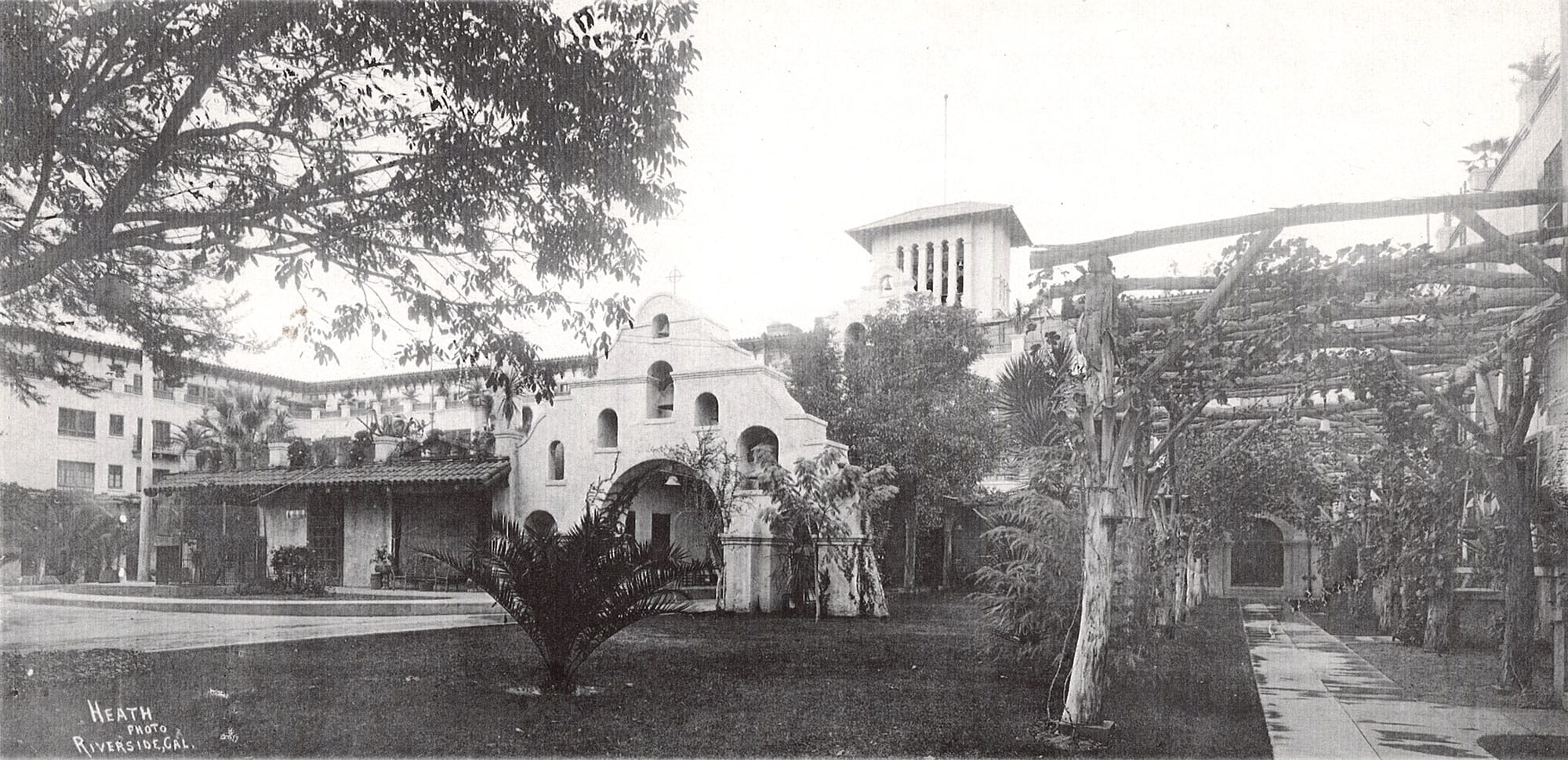
In April of 1916, the Salt Lake railroad announced plans to help erect pergolas along Seventh Street (today Mission Inn Avenue) from the train station to the center of town. From the drawings accepted by the railroad, W. Charles Tanner made attractive pictures of the proposed pergolas, which were displayed in the window of the Salt Lake’s office in Riverside. Tanner was an artist who had his studio in the Mission Inn. The pergolas were made of concrete posts, fashioned to resemble wood to be like the ones in the courtyard of the Glenwood Mission Inn. The railroad encouraged the citizens of Riverside to support this idea and secure the support of the property owners along Seventh Street.
H. A. Hammond had an even more ambitious plan. He wanted to see the pergolas extend the length of Seventh Street from the base of Mount Rubidoux all the way to the train stations. This dream of Hammond’s was too elaborate to bring about.
Naturally, Frank Miller of the Mission Inn became involved in the endeavor. Some claim that the original idea of extending the pergolas from his hotel to the depots was his inspiration. To further this project and other ventures related to Mission or Spanish art, Miller gathered civic leaders at his Glenwood Mission Inn, and on July 11, 1916, the Hispanic Arts Society of California was organized. Included among the early members were many prominent Riverside names. Miller had just seen the Spanish Wing of his Mission Inn completed in 1913-1914 and was filling the new Spanish Art Gallery with art.
The Hispanic Arts Association became a major supporter of the pergola project by bringing other organizations and groups together to raise the needed funds to construct the arbors over the sidewalks from the depots to the downtown area. The estimated cost for the improvements was $1000 a block. By August, the Association had raised enough money to cover seven of the twelve blocks.
By October, the Spanish Art Society (a new name for the organization) asked permission to erect a section of a grape arbor as a sample on the south side of Seventh Street east of Lime Street as a sample. Fred Schupbach was soon ready to begin the work with the first unit built in front of the Ward, Amstutz, & Glenn Undertaking Parlor property at 358 Seventh, between Lime and Mulberry. Today, this is the site of the Preston and Simons Mortuary at 3358 Mission Inn Avenue. The cement pergolas were about ten feet high and with a width of ten feet. The uprights were placed about eighteen feet apart. The wood replicas were hollow and reinforced by steel rods and mesh. Beams were laid across the top every five feet. The work did not begin though until early 1917 and progressed slowly before coming to a halt with the outbreak of war. At that time, the funds raised were invested in liberty bonds, with the interest increasing the amount held for the project.
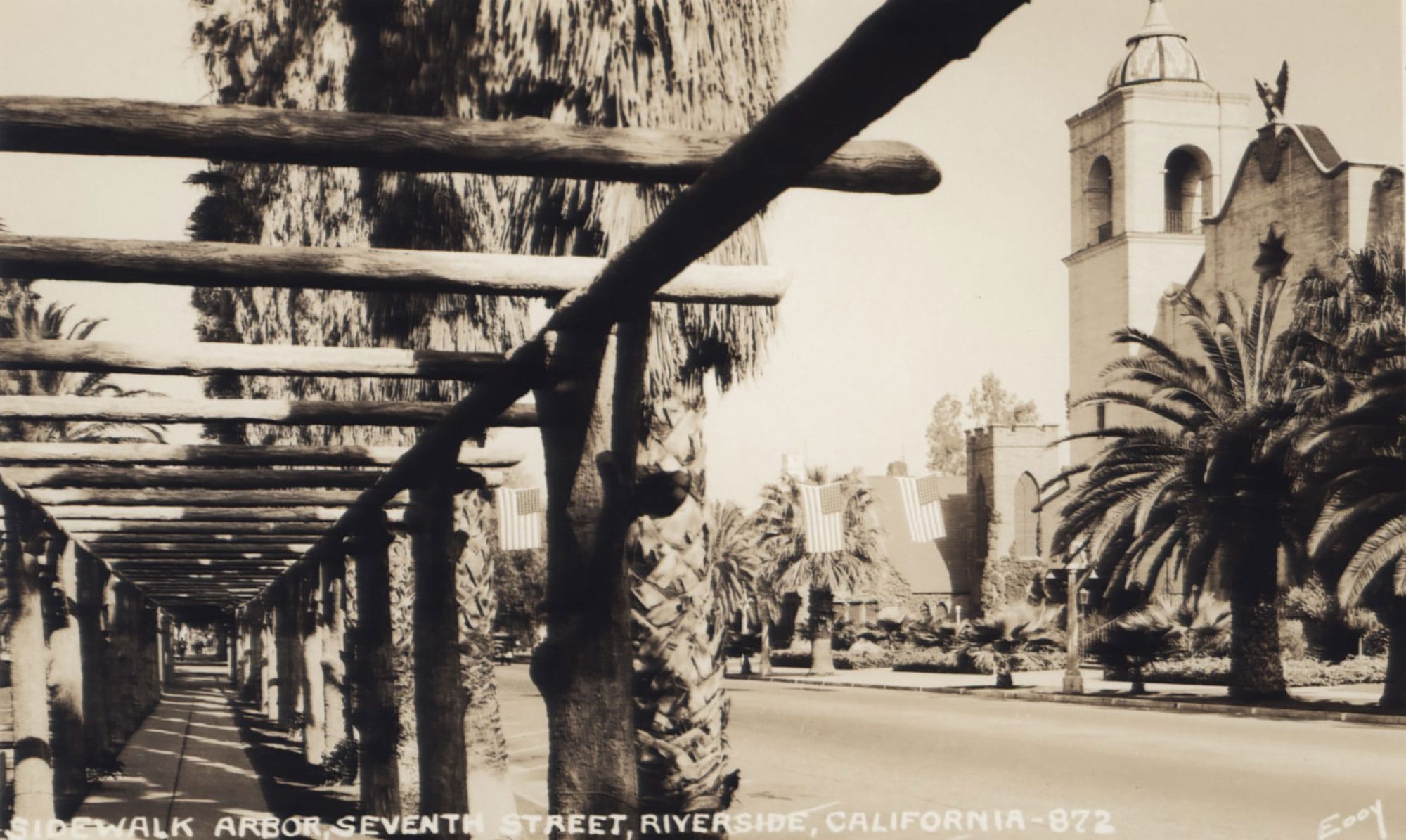
Not until November of 1928 did progress on the project resume. At that time, workmen were putting the finishing touches to three blocks of the pergola on Seventh Street, a partial fulfillment of a 14-year-old vision of the Spanish Arts Society of Riverside. The pergola then extended on the north side of Seventh Street from the Santa Fe depot to Lime Street.
In March of 1929, two homeowners on the south side of Seventh between Lime and Lemon Streets brought court action against the Spanish Art Society to stop the construction of the arbors in front of their property. B. B. Bush at 490 Seventh Street and Mrs. Alice Sharpe at 474 Seventh Street claimed that the pergolas infringed on their private property, obstructed the view and access to the homes, and decreased their property value. The case dragged on in the court system for months. Eventually, on November 19, 1929, Judge O. K. Morton ruled in favor of the Spanish Arts Society. He decreed that the pergolas would not infringe on the property rights of the owners.
That did not end the battle, though. On December 19, a crew of twelve men attempted to work on the construction of the pergola in front of the Bush residence. The reporter for the Daily Press wrote: “One white-haired woman, armed with a garden hose, for several hours today stood off a force of 12 men when Mrs. B. B. Bush guarded the Bush residence.” Mrs. Bush sprayed a vigorous stream of water all morning on the lawn and sidewalk. Whenever the workmen approached, she aimed the water at them, and they laughingly retreated. Police officer George Swanson observed the “battle” throughout the morning and declared that nothing unlawful was happening.
However, that was not the end of protests against the erection of the arbors. On January 7, 1930, at the first meeting of the year of the city council, the boards of the First Congregational Church, the Memorial Auditorium, and the Y.W.C.A. brought objections to the erection of the pergolas in front of their property. The trustees of the church objected that the pergolas would hide the architectural beauty of the church, that vines clinging to the pergola would not only prove a hindrance in time of fires but that a menace would also be offered the passerby on dark nights from the criminally inclined. The pergolas were never extended in front of these buildings.
By 1937, the question arose whether the ornamental arbors or pergolas over the sidewalks on Seventh Street, from Santa Fe station to Lemon Street, were serving a useful purpose from the standpoint of convenience and city beautification?” Public opinion differed greatly on the topic.
Frank Miller’s dream never came fully to fruition, much less the dream of H. A. Hammond to extend them all the way to the base of Mount Rubidoux. After the city granted permission to remove the pergolas, the Daily Press recounted that “erected originally by the Spanish Arts Society, the pergolas extend on both sides of Seventh Street, from the Santa Fe railroad to Lime and then on the southerly side one block further, ending at Lemon.”
On June 8, the city council unanimously instructed the city attorney, Eugene Best, to draw up a resolution canceling the permit for the Seventh Street pergolas. They did not immediately come down, but by January of the next year, work began to remove sections. Some of the removed pieces were loaded into trucks and transported up Box Springs grade to be reassembled on the grounds of the picturesque hillside home of G. F. Hix. Another section, alongside North Park, which is located between the Santa Fe and the Union Pacific Depots, was not removed in January 1960. The final sections along Seventh Street by North Park were taken down in November of 2017. The Old Riverside Foundation rescued these pieces and reinstalled them at their Weber House location.
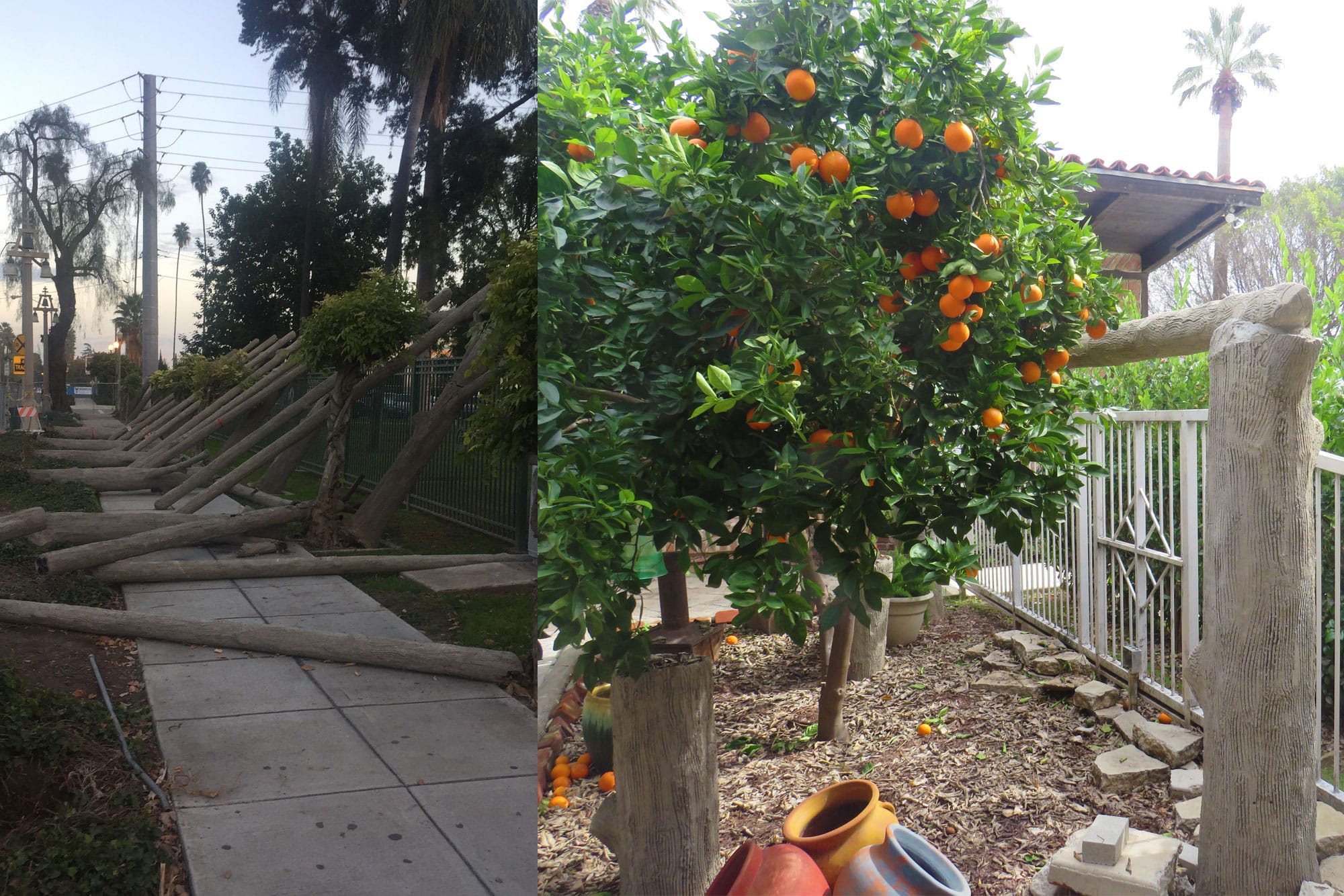
Today, only two short sections of the historical pergolas remain on Seventh Street. One section is in front of the Old Spaghetti Factory at 3191 Mission Inn Avenue. The structure was originally built in 1912 by the Salt Lake Route and leased to the Sutherland Packing Company. The second surviving section is in front of Heroes Restaurant and Brewery at 3397 Mission Inn Avenue. The restaurant building was designed by G. Stanley Wilson and built in 1923 as the headquarters for the Riverside-Arlington Heights Fruit Exchange.
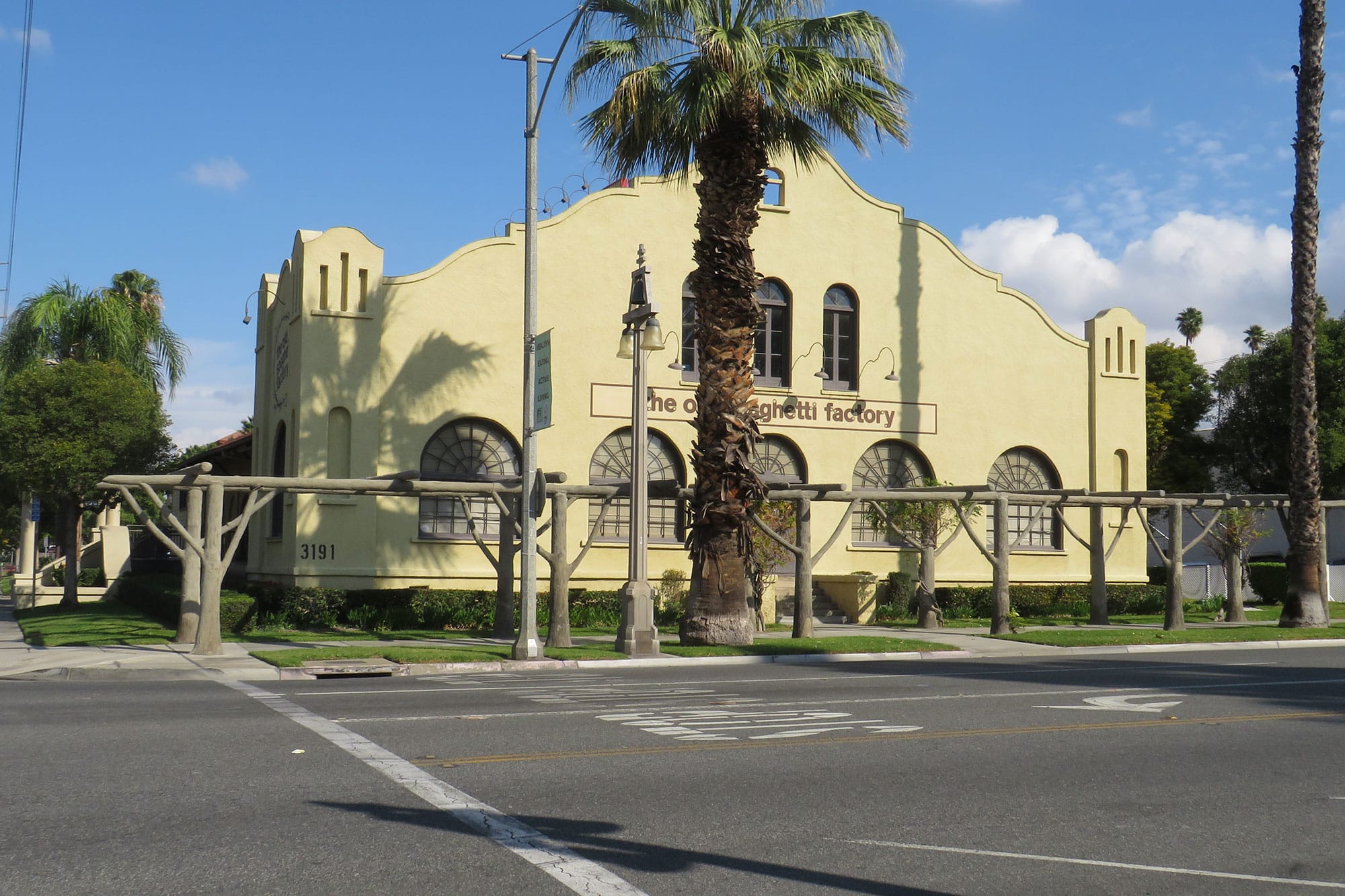
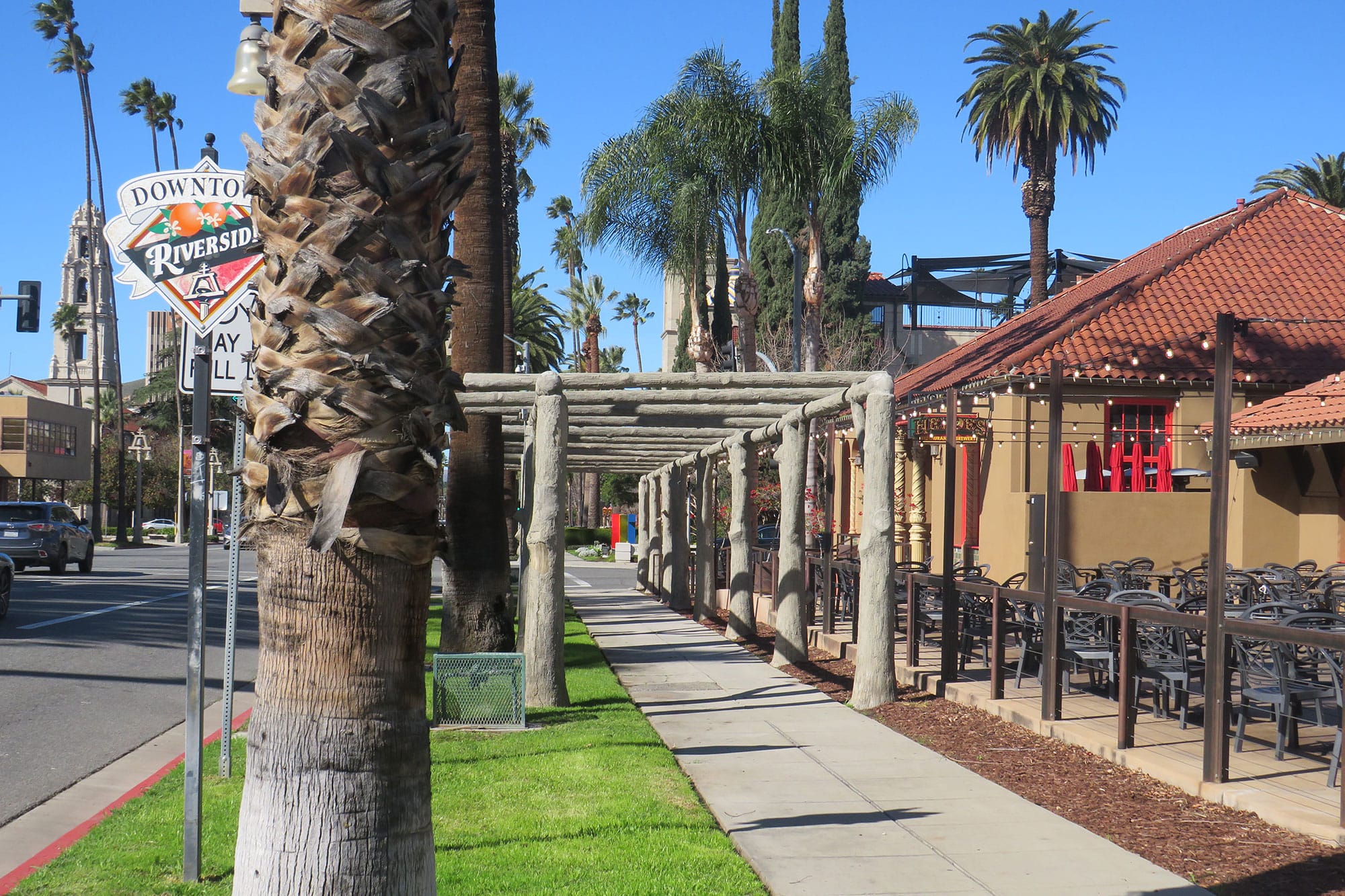
The Old Spaghetti Factory with historic pergolas in front (left) and pergolas in front of Heroes Restaurant (right, photos by Author).
Many people probably do not realize that these remnants are from a long-ago era when people came to Riverside by train and would walk the few blocks to the Mission Inn and downtown Riverside under the shaded protection of the pergolas along Seventh Street.
Let us email you Riverside's news and events every morning. For free!